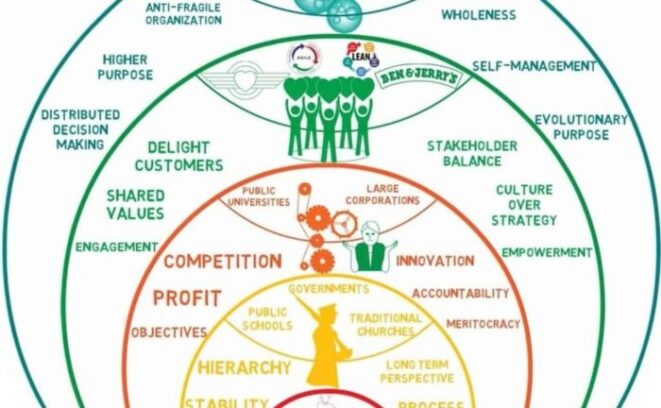Teal organizations, the short version
Teal organizations are an emerging model based on living systems and aimed at garnering higher member well-being, improved resilience, and greater contributions to the common good. They are built around three core principles:
- Self-management – a system based on peer relationships
- Wholeness – an invitation for members to bring “all of who they are”;
- Evolutionary purpose – organizational objectives that continuously adapt and evolve
Teal organizations, the longer version
Emerging organizational theory posits that throughout history organizational structures have gone through many stages of evolution.
The first organizations (called “red”), using the main metaphor of a wolf pack, were simple war bands controlled by a leader, often through fear and dominance. Think street gangs or crime syndicates. In time, organizations started becoming more advanced, using much more sophisticated hierarchies and implementing long-term planning made possible by stable leadership (“amber”). Think armies or the Catholic Church. After this, organizations become more machine-like (“orange”), implementing meritocracy and competition within the organization and focused on objectives-based management. Next, organizations strived to incorporate more meaning and humanity (“green”), developing consensus-based processes and prioritizing empowerment.
Teal organizations represent the next phase of the evolution of organizational structures. Where green organizations often become mired in endless processes striving toward consensus and inefficiencies caused by several levels of hierarchy and decision-making authority, teal organizations strive to foster responsible, functional autonomy and distributed decision-making. According to Frederic Laloux, author of Reinventing Organizations:
Every stage of organizational evolution is more mature and effective than the previous stage, because of the inherent attitude toward power. A Red leader asks, How can I use my power to dominate? An Amber leader asks, How can I use it to enforce the status quo? An Orange leader asks, How can we win? A Green leader asks, How can we empower more people? A Teal leader asks, How can everyone most powerfully pursue a purpose that transcends us all?

Teal organizations are based on three core principles:
1. Self-management
Teal organizations empower individuals to make decisions in their realm of influence and expertise. Members have autonomy to make certain decisions but are trusted and expected to consult and garner buy-in for all those affected by that decision. As such, power and authority are deeply embedded at every level of the organization, not just held by a few at the top.
2. Wholeness
Teal organizations acknowledge that members are most productive and innovative when they are invited to bring their whole selves to work. No longer expected to wear a mask at work, members unleash their creativity, passion, and loyalty in service to the organization’s goals.
3. Evolutionary purpose
Lastly, teal organizations are highly agile and adaptive in their organization focus and objectives. They sense what is happening in the world, what is being asked of them, and how they can best serve the common good, and adapt accordingly. In doing so, they are highly adept at finding impactful and profitable market niches and ensuring relevance.
Teal organizations, in practice
Buurtzorg is a highly decentralized network of over 9,000 nurses supported by only around 50 staff people. Buurtzorg operates via small self-managing teams of around 12 nurses serving a specific community, who are tasked with allocating their own tasks, renting offices, collaborating with hospitals, taking corrective action when needed, and more. It achieves incredible efficiency by trusting its nursing teams to make good decisions and adapt quickly to their communities’ unique needs and interests.
Launched in 2006, Buurtzorg now has 60% of market share in the Netherlands. One 2009 study found that Buurtzorg requires 40% of the care hours needed by other approaches because patients become self-sufficient much faster. In short, Buurtzorg is both highly successful as a business and effective at achieving its purpose.
The road to becoming a teal organization can be long and difficult. Many people simply cannot imagine an organization not based on hierarchies, not focused solely on profit, or where they are welcomed to bring their whole, true selves. But organizations can begin this transition by simply focusing on implementing one of the three core principles, for example:
- Fostering autonomy by ensuring each employee has decision-making power over at least one important organizational decision
- Convening policies and practices (e.g., weekly discussion circle, bring pets to work) that allow greater access to individual’s true selves, interests, and desires
- Defining the organization’s purpose and contribution to the common good beyond profit-making
Recommended reading
Reinventing Organizations: A Guide to Creating Organizations Inspired by the Next Stage of Human Consciousness
by Frederic Laloux
“Reinventing Organizations” describes in practical detail how organizations large and small can operate in this new paradigm. Leaders, founders, coaches, and consultants will find this work a joyful handbook, full of insights, examples, and inspiring stories.


